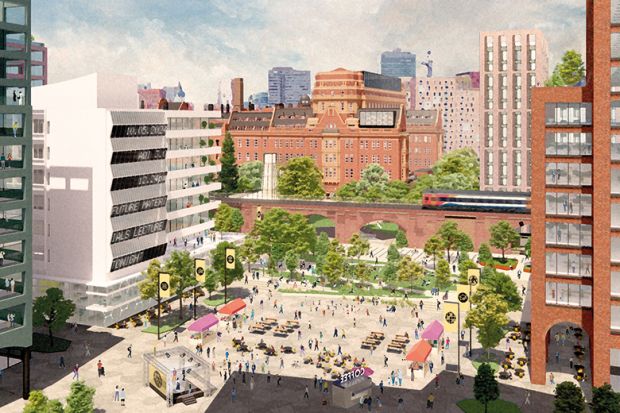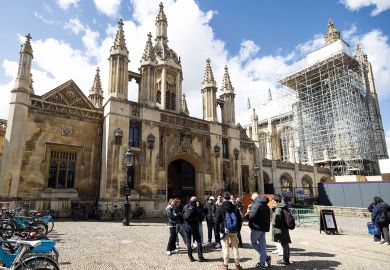Turn away from Manchester Piccadilly station and its crowds, head down quiet Altrincham Street, past the lads hanging around under the railway viaduct arches and in five minutes you’ll be in Vimto Park – named for the soft drink of indeterminate flavour first produced at a factory on the site in 1908 – beside the University of Manchester’s giant, empty Sackville Street Building, a mash-up of Edwardian terracotta and mid-20th-century extension.
At present, the campus of the former University of Manchester Institute of Science and Technology (Umist), merged into the University of Manchester in 2004, is a jumble of classic civic university architecture and classic 1960s modernist university tower blocks, bounded by the Mancunian Way – a classic, catastrophic 1960s city-centre elevated motorway.
But over the next 15 years, the plan is to turn the site into ID Manchester, a £1.7 billion project envisioned as “one of the world’s leading applied innovation districts”, with space for 10,000 workers. The scheme, a joint venture between the University of Manchester and specialist property developer Bruntwood SciTech, took a step forward last month when a strategic regeneration framework for the project was submitted to Manchester City Council.
Innovation districts built by partnerships between universities and companies – such as the Massachusetts Institute of Technology’s Kendall Square, which blends housing, retail, laboratories and research space – are in fashion. Such developments are often populated only by those with high incomes and can drive out entrepreneurs in favour of big companies able to pay high rents, cementing divides between haves and have-nots, critics caution. However, this is billed as a distinct Manchester inflection, as “inclusive innovation” that will create not only digital or technology jobs in the city centre, but also jobs in advanced manufacturing in the struggling towns on Greater Manchester’s northern and eastern fringes.
Campus resource: Unlocking knowledge within local communities as part of levelling up
ID Manchester is thus a project grappling with big ideas: the critical task of regional economic development, central to the UK’s politics; and whether university research can be deployed to foster innovation that, instead of rocket-boosting inequality as Silicon Valley now does, creates good jobs for people from a range of social backgrounds.
ID Manchester comes after a lengthy process of rationalising the University of Manchester’s estate, resulting in 20 acres of prime city-centre land on the former Umist campus becoming available for new use.
Rather than selling off the land for student housing, the university opted for a development that “gives something back to the city in terms of jobs and growth”, said John Holden, its assistant vice-president for major special projects.
The aim is to build a natural home in Manchester for the “ecosystem” in which innovation thrives, to use the university’s established areas of research strength – digital, artificial intelligence, advanced materials, biotech, healthcare – to foster spin-offs, attract big-name R&D spenders that the city presently does not have (who tend to want to be near spin-outs to hoover up their talent or buy them); and to bring into the city the venture capitalists who fund science and tech businesses.
There will not be any university buildings at ID Manchester; rather, the development will be office and lab space, incubators, maker spaces, places to eat and drink, a new public square and green space, plus about 1,300 apartments. If the plans go ahead, work on the centrepiece of ID Manchester, the Sackville Street Building, will begin in 2024, with an aim to preserve the building’s historic exterior while blending uses such as hotel, conferencing or co-working space within.
But ID Manchester’s location will make use of proximity to the university. Right next to the site, for example, is its glossy Graphene Engineering Innovation Centre (GEIC), focused on commercialising the super-thin material developed in Nobel Prize-winning research at the university. Head under the roaring Mancunian Way and in a couple of minutes you’ll be on Oxford Road, the bustling main home of the University of Manchester and Manchester Metropolitan University.
Bringing an R&D-led economy to Manchester is seen as crucial, because research and development is one of the drivers in boosting firms’ productivity, the value created per hour of work, by helping them to create new products and services.
Productivity is Greater Manchester’s big challenge, and ensuring that it no longer lags behind the national average “is going to be critical to creating good-quality jobs that pay well for local residents”, said Mr Holden, a former assistant director for strategy and research at the Greater Manchester Combined Authority. “The university has a key role to play in that for the city”, and it aims for that productivity growth to be “spilling out, benefiting places across the wider region”, he added.
ID Manchester fits within a bigger strategy, Innovation Greater Manchester (IGM), which unites local and regional government, business and universities. IGM became one of three “innovation accelerators” that won Westminster government funding in the Levelling Up White Paper last year. It intends to build a cohesive, region-wide strategy linking city-centre innovation into other key developments in the city region, notably Atom Valley, a planned advanced manufacturing arc across sites in Bury, Rochdale and Oldham (the name references Ernest Rutherford’s pioneering work in splitting the atom at the University of Manchester in 1917).
“We’d hope that lots of those spin-outs would make their first steps to independence on ID Manchester, so they’re close to the university, close to the research facilities they came from,” said Richard Jones, the University of Manchester’s vice-president for regional innovation and civic engagement, and independent science adviser to IGM. “But we’d like them, when they move into production, to do the production in Atom Valley.”
To make places such as Rochdale, Oldham and Bury – hit hard by deindustrialisation but with the space for advanced manufacturing not available in central Manchester – wealthier, “the primary thing you need to do is attract businesses that will produce tradable goods and services that will bring money into those places”, Professor Jones continued.
University-led projects funded with the IGM innovation accelerator money seek to build that bridge between city-centre innovation and Atom Valley; the Manchester Turing Innovation Hub, which is focused on supporting Greater Manchester start-ups particularly in the field of AI, is to be headquartered at ID Manchester but with offshoots including one in Rochdale.
Or if you want a potentially more concrete example: a spin-off company from Nationwide Engineering Group – the new company is founded by a University of Manchester graduate and partnered with the GEIC – recently announced £8 million of venture capital funding to bring to full commercial use Concretene, a graphene-strengthened form of concrete that saves significantly on carbon dioxide emissions because it shrinks the volume of material by 30 per cent and reduces the need for steel reinforcement (concrete production accounts for 8 per cent to 10 per cent of worldwide carbon dioxide emissions).
The potential of bringing Concretene to production – perhaps at a factory in Atom Valley – “starts to show how the activity clustered here in the city centre can spread out and benefit more parts of the city region”, said Mr Holden.
But might ID Manchester be seen as just a property development scheme? The university’s partner is, after all, a property developer – Bruntwood SciTech being a joint venture itself, between Legal & General and Bruntwood, a Manchester-founded property company (whose chief executive, Chris Oglesby, chairs the IGM board).
“Whilst there have been many globally successful innovation districts, often they work for the shareholders and the investors, not necessarily for the local community,” acknowledged Lou Cordwell, director of ID Manchester and chair of the Greater Manchester Business Board.
But ID Manchester has an internal manifesto about “the kinds of organisations and the kind of growth we want to drive”, centred on “growth that works for all people and for the planet”, while its position as privately funded gives it long-term scope to pursue those goals often not open to government-funded projects with short-term political drivers, she argued.
There’s also an objective about “stitching [the development] into the local community” of surrounding Ardwick and Brunswick, among the most deprived parts of Greater Manchester, so “the 10-year-olds living there now can have the tech jobs, the R&D jobs, on ID Manchester in the future”, said Mr Holden.
ID Manchester “needs to wash its face” financially, but it is “the ecosystem it creates which is really transformational for us”, he went on. For the university, he added, “if we get it right, we should have hundreds of big R&D spenders on our doorstep,” bringing greater scope for its researchers to collaborate with industry, plus making Manchester “a much more attractive place to come and study” for students, who could find internships or graduate jobs with companies at ID Manchester.
Professor Jones said there was an “understandable but incorrect view” in national debate that city centres such as Manchester “suck the life out of the towns” around them. The reality, he added, was that Manchester city centre is “not doing well enough to suck the life out of anything – it needs to be doing better”.
Can ID Manchester really attract the R&D big names it wants to, in the face of competition with the golden triangle?
In the post-pandemic view of the world taken by many company leaders and workers, said Ms Cordwell, “the answer might not be that you have to be in London, Oxford or Cambridge; and if the answer is that you [don’t] because that doesn’t enable the quality of life and the values you are now looking to live by, then Manchester becomes a very obvious answer very quickly.”
If you’re a Manchester sceptic (you’re probably from Leeds), you might see typically Mancunian big talk here. But in a city that has long been a cradle of both industry and social reform movements, with a tradition of strong civic leadership and collaboration now turned towards building a strategy for an innovation-led economy that creates a variety of jobs in variety of places, the ground might be fertile for an experiment in inclusive innovation.
Register to continue
Why register?
- Registration is free and only takes a moment
- Once registered, you can read 3 articles a month
- Sign up for our newsletter
Subscribe
Or subscribe for unlimited access to:
- Unlimited access to news, views, insights & reviews
- Digital editions
- Digital access to THE’s university and college rankings analysis
Already registered or a current subscriber?











